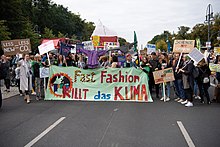User:Stella88E/Fast fashion
Appearance
| This is the sandbox page where you will draft your initial Wikipedia contribution.
If you're starting a new article, you can develop it here until it's ready to go live. If you're working on improvements to an existing article, copy only one section at a time of the article to this sandbox to work on, and be sure to use an edit summary linking to the article you copied from. Do not copy over the entire article. You can find additional instructions here. Remember to save your work regularly using the "Publish page" button. (It just means 'save'; it will still be in the sandbox.) You can add bold formatting to your additions to differentiate them from existing content. |

According to the United Nations Economic Commission for Europe,[2] the fast fashion system provides opportunities for economic growth but the entire fashion industry hinders sustainability efforts by contributing to 20% of wastewater. In addition, fast fashion is responsible for nearly 10 percent of global gas emissions. Providing insight, the Ellen Macarthur Foundation released study results on fashion and suggests a new circular system. A singular t-shirt requires over 2,000 liters of water to make.[3] Clothing is not utilized to its full potential, the Ellen MacArthur Foundation explains that linear systems are contributing to unsustainable behavior and the future of fashion may need to transition towards a circular system of production and consumer behavior.[citation needed] Journalist Elizabeth L. Cline, author of Overdressed: The Shockingly High Cost of Cheap Fashion and one of the earliest critics of fast fashion, notes in her article Where Does Discarded Clothing Go?[4] that Americans are purchasing five times the amount of clothing than they did in 1980. Due to this rise in consumption, developed countries are producing more and more garments each season. The United States imports more than 1 billion garments annually from China alone.[5] United Kingdom textile consumption surged by 37% from 2001 to 2005.[6] The Global Fashion Business Journal reported that in 2018, the global fiber production has reached the highest all-time, 107 million metric tons.[7] The average American household produces 70 pounds (32 kg) of textile waste every year.[8] The residents of New York City discard around 193,000 tons of clothing and textiles, which equates to 6% of all the city's garbage.[4] In comparison, the European Union generates a total of 5.8 million tons of textiles each year.[9] As a whole, the textile industry occupies roughly 5% of all landfill space.[8] The clothing that is discarded into landfills is often made from non-biodegradable synthetic materials.[10] Greenhouse gases and various pesticides and dyes are released into the environment by fashion-related operations.[11] The United Nations estimated that the business of what we wear, including its long supply chains, is responsible for 10 percent of the greenhouse gas emissions heating our planet.[12] The growing demand for quick fashion continuously adds effluent release from the textile factories, containing both dyes and caustic solutions.[13] In comparison, greenhouse gas emissions from textile production companies is more than international flights and maritime shipping combined annually. The materials used not only affect the environment in textile product, but also the workers and the people who wear the clothes. The hazardous substances affect all aspects of life and release into the environments around them.[14] Optoro estimates that 5 billion pounds of waste is generated through returns each year, contributing 15 million metric tons of carbon dioxide to the atmosphere.[15] Fast fashion production has doubled since 2000, with brands such as Zara producing 24 collections a year and H&M producing about 12 to 16 collections a year.[16]
[edit]- ^ stuff), Stefan Müller (climate (2019-09-20), Fast Fashion killt das Klima, retrieved 2021-12-01
- ^ Nations, United Nations Economic Commission for EuropeInformation UnitPalais des; Geneva 10, CH-1211; Switzerl. "UN Alliance aims to put fashion on path to sustainability". www.unece.org. Retrieved 2020-03-24.
{{cite web}}: CS1 maint: numeric names: authors list (link) - ^ "A NEW TEXTILES ECONOMY: REDESIGNING FASHION'S FUTURE" (PDF). www.ellenmacarthurfoundation.org. Retrieved June 10, 2021.
{{cite web}}: CS1 maint: url-status (link) - ^ a b Cline, Elizabeth (July 18, 2014). "Where Does Discarded Clothing Go?". The Atlantic. The Atlantic Monthly Group. Retrieved October 24, 2015.
- ^ "Profile of H&M: A Pioneer of Fast Fashion". Textile Outlook International / (130): 11–13. 2007. ISSN 0268-4764. OCLC 181071608.
- ^ The sustainable fashion handbook. Sandy Black. New York: Thames & Hudson. 2013. ISBN 978-0-500-29056-9. OCLC 800642264.
{{cite book}}: CS1 maint: others (link) - ^ "Global fiber production reaches all-time high, preferred cotton share rises". www.themds.com. Retrieved 2019-11-30.
- ^ a b "Council for Textile Recycling". www.weardonaterecycle.org. Retrieved 2015-11-08.
- ^ DuFault, Amy (16 April 2014). "Can 'upcycling' give Haiti's fashion industry a boost?". The Guardian. Retrieved 2015-11-08.
- ^ "Environmental impact of the textile and clothing industry" (PDF). European Parliament.
- ^ "Fast Fashion Is the Second Dirtiest Industry in the World, Next to Big Oil". ecowatch.com. August 17, 2015. Archived from the original on June 4, 2021. Retrieved June 10, 2021.
- ^ "A scrappy solution to the fashion industry's giant waste problem". Grist. Aug 2, 2019.
- ^ Lowson, Bob (1999). Quick response : managing the supply chain to meet consumer demand. Russell King, Alan Hunter. Chichester, West Sussex, England: Wiley. ISBN 0-585-20972-3. OCLC 44962828.
- ^ MacArthur, Ellen. "A New Textiles Economy: Redesigning Fashion's Future" (PDF). ellenmacarthurfoundation.
- ^ "Your brand new returns end up in landfill | BBC Earth". www.bbcearth.com.
- ^ McFall-Johnsen, Morgan. "The fashion industry emits more carbon than international flights and maritime shipping combined. Here are the biggest ways it impacts the planet". Business Insider. Retrieved 2021-03-01.
